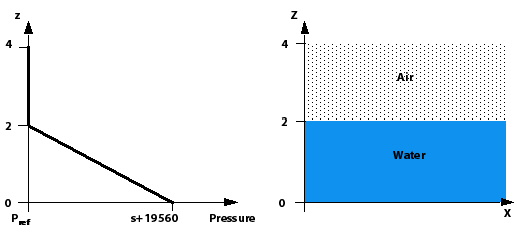For the Buoyancy Reference Density, choose the density of the light fluid (air). This simplifies the definition of pressure, and hence the specification of pressure initial and boundary conditions. In the hydrostatic limit:
(7–19) |
For details, see Buoyancy.
If the inhomogeneous multiphase model is selected, using the homogeneous turbulence option is recommended. For details, see Homogeneous Turbulence in Inhomogeneous Flow.
Make sure that a pressure level has been set by one of the boundary conditions. For "closed box" cases, you can add a small opening to achieve this.
A pressure level must be set at one or more boundary conditions by using the Pressure Level Information option on the Solver Control tab in CFX-Pre. For details, see Turbulence Control. To set a pressure reference value using a boundary condition for "closed box" cases, this can be achieved by adding a small pressure opening to the top wall.
At pressure outlets, the elevation of the water must usually be known as part of the problem definition. The mechanism used to enforce this elevation is to set a pressure profile consistent with the known elevation. In some circumstances, the elevation is not known in advanced (for example supercritical outlets). In this case, it is best to specify a pressure profile consistent with an estimate for the outlet elevation. This assumption should not affect the flow other than possibly inducing a small kink in the flow just upstream of the outlet condition.
The initial conditions for the pressure field and volume fraction must be consistent (that is, the pressure field is hydrostatic in the heavy phase and uniform in light phase). This is easily done using CEL step functions. For example, the functions:
(7–20) |
(7–21) |
(7–22) |
(7–23) |
would be appropriate to initialize the relative pressure field and volume fractions as shown below.

In the equation for initialVOFAir, the division is required because the step function must operate on dimensionless quantities.
The timestep for free surface flows should be based on a L/U (Length/Velocity) scale. The length scale should be a geometric length scale. The velocity scale should be the maximum of a representative flow velocity and a buoyant velocity, which is given by:
(7–24) |
In addition, it is often helpful to reduce the timestep for the volume fraction equations by an order of magnitude below that of the other equations.
When using free surface with adaption, make sure the interface is no longer moving before doing an adaption step, otherwise the adaption will be a wasted effort.
The Body Force Averaging Type controls how body forces
(buoyancy in particular) are averaged to elements. The default option of
Volume-Weighted should be used in most cases. For free
surface flows, you may want to use the Harmonic option;
this is a little more robust and is less prone to generate spurious velocities
in the gas phase adjacent to the interface. However, harmonic averaging does not
converge as well as volume-weighted averaging. The arithmetic option is very
similar to the Volume-Weighted option.
Convergence is often hard to achieve in a residual sense. Instead use some global quantity to check if the solution is changing. Failure to converge residuals is often manifest as small spurious waves on the free surface interface. These waves may be reduced in magnitude if the timestep for the volume fraction equation is an order of magnitude smaller than for the momentum equation.
In some cases, using the double precision solver executable can improve convergence.
Free surface may not be robust in parallel if any portion of a partition boundary is aligned with the free surface. In this case, consider trying another of the partitioning methods (recursive bisection or specified direction). If GGI boundaries are present and the domains are of the same physical type (fluid/porous and solid), consider using coupled partitioning. Finally, reducing the value of the expert parameter ‘overlap relaxation fluids’ from its default value of 1 may be helpful.


